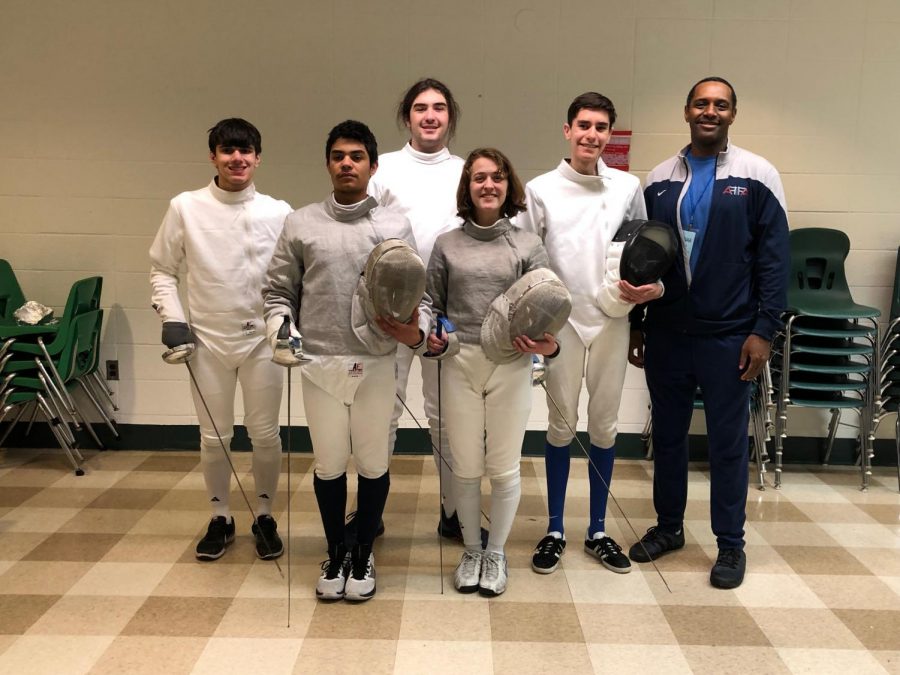En garde! Fencing Club fights for recognition
Photo Emily O’Connell
Members of the Fencing Club at a meet earlier this year.
Fencing. Many are quick to label it as outdated and foreign, associating it more so with ancient Olympic Games than the 21st century. Yet here at WHS, this less-heralded sport is quietly overcoming adversity en route to gaining local acclaim.
The WHS Fencing Club, founded in 2013, functions similarly to other athletic staples. Athletes partake in bi-weekly practices at the Advance Fencing & Fitness Academy in Garwood and participate in select tournaments throughout the year. On top of that, the club has formed what senior Jasper Lemberg calls a “genuinely enjoyable, supportive, tight-knit community.”
One of the reasons why fencing has yet to establish itself as a mainstream sport is due to its difficulty in attracting athletes. While membership has increased this year, getting students to pick up fencing has not been an easy task for the Fencing Club. Notions that the sport is antiquated and extraneous has diminished overall interest amongst students.
“Most kids are throwing baseballs by the time they know how to write their name, but with fencing, most people don’t hear about it until they’re older,” Lemberg said. “At that point, they don’t know how to start and might not want to pursue it at all.”
Other constraints include the lack of television coverage and the fact that the rules of fencing can be hard to follow. Junior Captain Emily O’Connell pointed out that many are hesitant to fence because they mistakenly believe it to be violent.
“It sounds dangerous and intimidating, the fact that it involves swords,” she said. “But what people aren’t told is that fencing is actually one of the safest sports out there because of all the protective gear.” O’Connell mentioned that she has suffered no injury worse than a few minor bruises due to fencing.
Club Adviser Louis DeAngelo stresses the benefits of fencing that many fail to see when looking at the sport on the surface: “It’s a fast-paced, individual-based sport, with each match being one-on-one as opposed to being a team sport,” he said. “The time commitment is also less than what you would find on a traditional varsity team, so it’s something one could potentially fit more easily into a schedule.”
O’Connell added that she would recommend fencing to anyone who believes that “sports are not their thing,” emphasizing that it has more to do with mental strategy than athletic ability.
“It’s mostly a mind game rather than being overly athletic,” she said. “It’s all just thinking about how to get the touch on that one opponent, keeping you on your toes. It’s like a really fast-paced game of chess, only with swords.”
Nationwide, fencing is picking up traction as a popular sport, among younger ages in particular. According to a study done by the National Sporting Goods Association, out of all competitive fencers, 41.5% are between the ages of 12-17 and 21.4% 18-24, each the highest percentage in their cohort in comparison with other major sports.
American fencers too have ascended to the global stage; in 2016 at the Summer Olympics in Rio de Janeiro, the United States collectively compiled one of the most fencing successful campaigns for the country in decades.
Such successes prompted Lemberg and others to join the Fencing Club here at WHS. “You watch it in the Olympics, and you marvel at the speed and technique of the fencers,” Lemberg said. “But as soon as you get back to Westfield, you realize that it’s not really a big thing. So once I heard about it, I had to seize the opportunity and at least try it.”
Moving forward, the Fencing Club aims to continue the sport’s upwards trajectory, overcoming preconceptions to achieve more credibility. To DeAngelo, the feat is more than attainable.
“This group has continued creating a clear path for what it wants to be, and recognizing what needs to be done to get there,” he said. “The ultimate goal is definitely to achieve varsity team status at some point down the road.”

